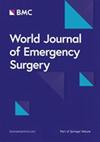初始乳酸水平和红细胞输注策略与严重创伤后疗效的关系:RESTRIC 试验的事后分析
IF 6
1区 医学
Q1 EMERGENCY MEDICINE
引用次数: 0
摘要
对于外伤后有活动性出血的患者,限制性输血策略是否合适仍不确定。鉴于组织缺氧与乳酸水平之间的关联,我们假设最佳输血策略可能因乳酸水平而异。这项对 RESTRIC 试验的事后分析旨在根据初始乳酸水平调查输血策略与患者预后之间的关联。我们对 RESTRIC 试验进行了事后分析,该试验是一项分组随机、交叉、非劣效多中心试验,比较了针对有大出血风险的成人创伤患者的限制性和自由性红细胞输注策略。该试验是在创伤抢救的初始阶段进行的,即从急诊科到达到入院或重症监护室(ICU)出院后的 7 天内。根据患者到达急诊科时的乳酸水平进行分组:低乳酸水平(< 2.5 mmol/L)、中乳酸水平(≥ 2.5 和 < 4.0 mmol/L)和高乳酸水平(≥ 4.0 mmol/L)。我们使用多元线性回归比较了各组间的 28 天死亡率、无 ICU 天数和无呼吸机天数。在422名RESTRIC试验参与者中,我们对396名参与者进行了分析,他们的乳酸水平分别为低(n = 131)、中(n = 113)和高(n = 152)。在所有乳酸盐组中,不同策略的 28 天死亡率相似。然而,在低乳酸组中,与宽松策略相比,限制性方法与更多无 ICU 天数(β 系数为 3.16;95% CI 为 0.45 至 5.86)和无呼吸机天数(β 系数为 2.72;95% CI 为 0.18 至 5.26)相关。即使排除了严重脑外伤患者,这些结果依然存在。我们的结果表明,无论乳酸水平如何,限制性输血策略可能不会对 28 天存活率产生显著影响。然而,对于初始血乳酸水平较低的患者来说,自由输血策略可能会导致无重症监护室和无呼吸机的天数缩短。本文章由计算机程序翻译,如有差异,请以英文原文为准。
Association of initial lactate levels and red blood cell transfusion strategy with outcomes after severe trauma: a post hoc analysis of the RESTRIC trial
The appropriateness of a restrictive transfusion strategy for those with active bleeding after traumatic injury remains uncertain. Given the association between tissue hypoxia and lactate levels, we hypothesized that the optimal transfusion strategy may differ based on lactate levels. This post hoc analysis of the RESTRIC trial sought to investigate the association between transfusion strategies and patient outcomes based on initial lactate levels. We performed a post hoc analysis of the RESTRIC trial, a cluster-randomized, crossover, non-inferiority multicenter trials, comparing a restrictive and liberal red blood cell transfusion strategy for adult trauma patients at risk of major bleeding. This was conducted during the initial phase of trauma resuscitation; from emergency department arrival up to 7 days after hospital admission or intensive care unit (ICU) discharge. Patients were grouped by lactate levels at emergency department arrival: low (< 2.5 mmol/L), middle (≥ 2.5 and < 4.0 mmol/L), and high (≥ 4.0 mmol/L). We compared 28 days mortality and ICU-free and ventilator-free days using multiple linear regression among groups. Of the 422 RESTRIC trial participants, 396 were analyzed, with low (n = 131), middle (n = 113), and high (n = 152) lactate. Across all lactate groups, 28 days mortality was similar between strategies. However, in the low lactate group, the restrictive approach correlated with more ICU-free (β coefficient 3.16; 95% CI 0.45 to 5.86) and ventilator-free days (β coefficient 2.72; 95% CI 0.18 to 5.26) compared to the liberal strategy. These findings persisted even after excluding patients with severe traumatic brain injury. Our results suggest that restrictive transfusion strategy might not have a significant impact on 28-day survival rates, regardless of lactate levels. However, the liberal transfusion strategy may lead to shorter ICU- and ventilator-free days for patients with low initial blood lactate levels.
求助全文
通过发布文献求助,成功后即可免费获取论文全文。
去求助
来源期刊

World Journal of Emergency Surgery
EMERGENCY MEDICINE-SURGERY
CiteScore
14.50
自引率
5.00%
发文量
60
审稿时长
10 weeks
期刊介绍:
The World Journal of Emergency Surgery is an open access, peer-reviewed journal covering all facets of clinical and basic research in traumatic and non-traumatic emergency surgery and related fields. Topics include emergency surgery, acute care surgery, trauma surgery, intensive care, trauma management, and resuscitation, among others.
 求助内容:
求助内容: 应助结果提醒方式:
应助结果提醒方式:


